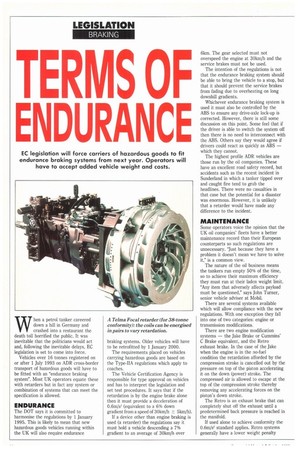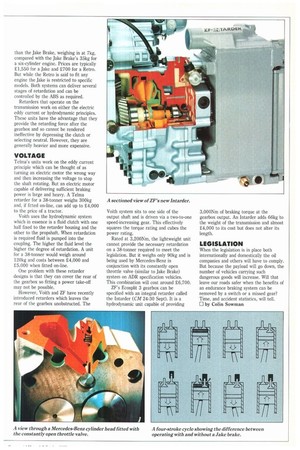TERMS OF
Page 40

Page 41

If you've noticed an error in this article please click here to report it so we can fix it.
ENDURANC
EC legislation will force carriers of hazardous goods to fit endurance braking systems from next year. Operators will have to accept added vehicle weight and costs.
When a petrol tanker careered down a hill in Germany and crashed into a restaurant the death toll horrified the public. It was inevitable that the politicians would act and, following the inevitable delays, EC legislation is set to come into force.
Vehicles over 16 tonnes registered on or after 1 July 1993 on ADR cross-border transport of hazardous goods will have to be fitted with an "endurance braking system". Most UK operators equate these with retarders but in fact any system or combination of systems that can meet the specification is allowed.
ENDURANCE
The DOT says it is committed to harmonise the regulations by 1 January 1995. This is likely to mean that new hazardous goods vehicles running within the UK will also require endurance braking systems. Older vehicles will have to be retrofitted by 1 January 2000.
The requirements placed on vehicles carrying hazardous goods are based on the Type-IA regulations which apply to coaches.
The Vehicle Certification Agency is responsible for type approval on vehicles and has to interpret the legislation and set test procedures. It says that if the retardation is by the engine brake alone then it must provide a deceleration of 0.6m/s2 (equivalent to a 6% down gradient from a speed of 30km/h ± 51tm/h).
If a device other than engine braking is used (a retarder) the regulations say it must hold a vehicle descending a 7% gradient to an average of 30km/h over 6km. The gear selected must not overspeed the engine at 30km/h and the service brakes must not be used.
The intention of the regulations is not that the endurance braking system should be able to bring the vehicle to a stop, but that it should prevent the service brakes from fading due to overheating on long downhill gradients.
Whichever endurance braking system is used it must also be controlled by the ABS to ensure any drive-axle lock-up is corrected. However, there is still some discussion on this point. Some feel that if the driver is able to switch the system off then there is no need to interconnect with the ABS. Others say they would agree if drivers could react as quickly as ABS — which they cannot.
The highest profile ADR vehicles are those run by the oil companies. These have an excellent road safety record, but accidents such as the recent incident in Sunderland in which a tanker tipped over and caught fire tend to grab the headlines. There were no casualties in that case but the potential for a disaster was enormous. However, it is unlikely that a retarder would have made any difference to the incident.
MAINTENANCE
Some operators voice the opinion that the UK oil companies' fleets have a better maintenance record than their European counterparts so such regulations are unnecessary. "Just because they have a problem it doesn't mean we have to solve it," is a common view.
The nature of the oil business means the tankers run empty 50% of the time, so to achieve their maximum efficiency they must run at their laden weight limit. "Any item that adversely affects payload must be questioned," says John Turner, senior vehicle adviser at Mobil.
There are several systems available which will allow compliance with the new regulations. With one exception they fall into one of two categories: engine or transmission modifications.
There are two engine modification systems — the Jake Brake or Cummins' C Brake equivalent, and the Retro exhaust brake. In the case of the Jake when the engine is in the no-fuel condition the retardation afforded by the compression stroke is cancelled out by the pressure on top of the piston accelerating it on the down (power) stroke. The compressed air is allowed to escape at the top of the compression stroke thereby removing any accelerating forces on the piston's down stroke.
The Retro is an exhaust brake that can completely shut off the exhaust until a predetermined back pressure is reached in the manifold.
If used alone to achieve conformity the 0.6m/s2 standard applies. Retro systems generally have a lower weight penalty
than the Jake Brake, weighing in at 7kg, compared with the Jake Brake's 35kg for a six-cylinder engine. Prices are typically £1,550 for a Jake and £700 for a Retro. But while the Retro is said to fit any engine the Jake is restricted to specific models. Both systems can deliver several stages of retardation and can be controlled by the ABS as required.
Retarders that operate on the transmission work on either the electric eddy current or hydrodynamic principles. These units have the advantage that they provide the retarding force after the gearbox and so cannot be rendered ineffective by depressing the clutch or selecting neutral. However, they are generally heavier and more expensive.
VOLTAGE
Telma's units work on the eddy current principle which can be thought of as turning an electric motor the wrong way and then increasing the voltage to stop the shaft rotating. But an electric motor capable of delivering sufficient braking power is large and heavy, A Telma retarder for a 38-tonner weighs 300kg and, if fitted on-line, can add up to £4,000 to the price of a tractor.
Voith uses the hydrodynamic system which in essence is a fluid clutch with one half fixed to the retarder housing and the other to the propshaft. When retardation is required fluid is pumped into the coupling. The higher the fluid level the higher the degree of retardation. A unit for a 38-tonner would weigh around 120kg and costs between £4,000 and £5,000 when fitted on-line.
One problem with these retarder designs is that they can cover the rear of the gearbox so fitting a power take-off may not be possible.
However, Voith and ZF have recently introduced retarders which leaves the rear of the gearbox unobstructed. The Voith system sits to one side of the output shaft and is driven via a two-to-one speed-increasing gear. This effectively squares the torque rating and cubes the power rating.
Rated at 3,200Nm, the lightweight unit cannot provide the necessary retardation on a 38-tonner required to meet the legislation. But it weighs only 90kg and is being used by Mercedes-Benz in conjunction with its constantly open throttle valve (similar to Jake Brake) system on ADR specification vehicles. This combination will cost around £6,700.
ZF's Ecospfit 3 gearbox can be specified with an integral retarder called the Intarder (CM 24-30 Sept). It is a hydrodynamic unit capable of providing
3,000Nm of braking torque at the gearbox output. An Intarder adds 66kg to the weight of the transmission and almost £4,000 to its cost but does not alter its length.
LEGISLATION
When the legislation is in place both internationally and domestically the oil companies and others will have to comply. But because the payload will go down, the number of vehicles carrying such dangerous goods will increase. Will that leave our roads safer when the benefits of an endurance braking system can be removed by a switch or a missed gear? Time, and accident statistics, will tell. El by Colin Sowman
















































































